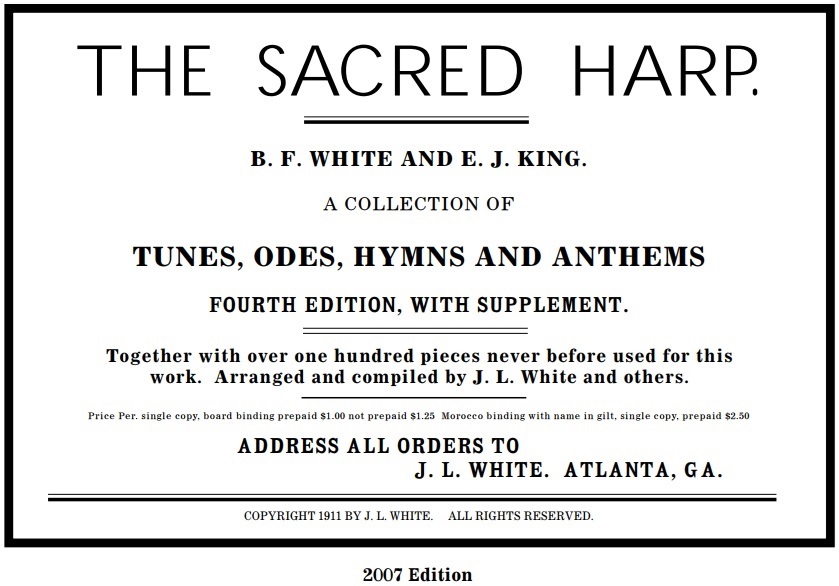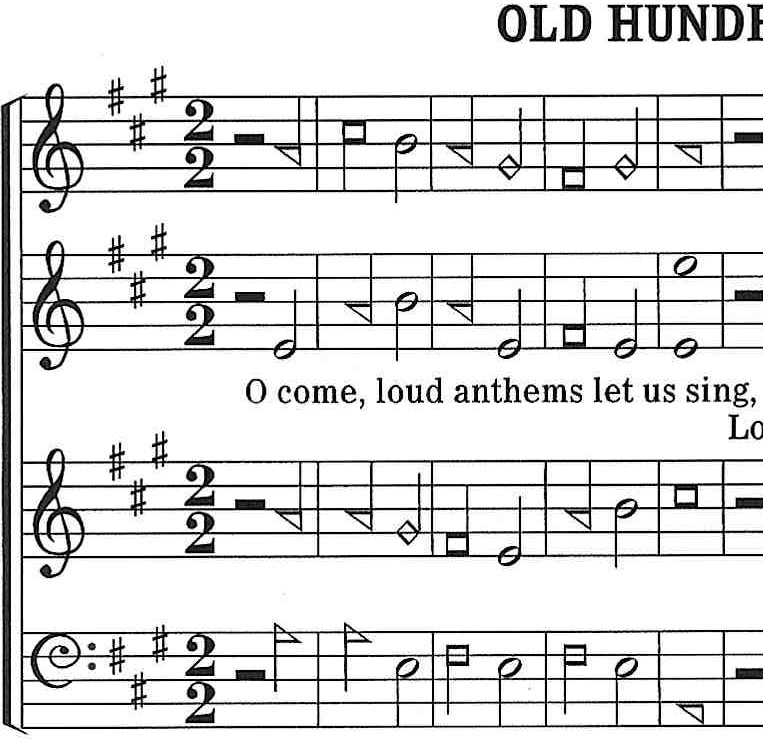



The Sacred Harp, a Collection of Psalm and Hymn Tunes, Odes, and Anthems, Fourth Edition, with Supplement was published in 1911 by James Landrum White (1847-1925) of Atlanta, Georgia, after publishing two books that failed to gain any usage. This third book would be more successful.
White was the son of Benjamin Franklin White, author of The Sacred Harp. After the death of the father in 1879, there was a movement almost immediately to modernize the old book. One of the proponents leading this movement was J. L. White. In 1884, White and his brother, B. F. White, Jr., published The New Sacred Harp. This book had 192 pages that included rudiments, 206 songs, and an index. White used the Aiken seven-shape music notation. Many songs in the book were of the gospel music style that Aldine Silliman Kieffer and Ephraim Ruebush began publishing a decade earlier. This book failed in achieving a wide or a lasting following.
In 1909, White published The Sacred Harp, A Collection of Psalm and Hymn Tunes, Odes and Anthems, Fifth Edition Entirely Remodeled and Improved. White gives credit to a 34-member committee as participating in the production of this book. Two members of this committee were on W. M. Cooper's committee for his 1902 edition: T. W. Loftin and W. R. McCoy. Four members of this committee would be later listed as serving on J. S. James' committee for his 1911 edition: M. F. McWhorter, S. M. Denson, T. J. Denson, and A. Ogletree. Ogletree and fellow committee member, H. S. Reese, served on revision committees with B. F. White, Sr. in his editions. J. S. James writes in his introduction to his 1911 Original Sacred Harp, "Several attempts have been made within the last two or three years to revise The Sacred Harp by others, but the work was done in such a way this committee could not endorse and accept the same, although their names are attached to some of these books as endorsing them. This, however, is without authority by the members of the committee."
In his preface, White writes: "Owing to an almost universal demand for a revision of the B. F. WHITE SACRED HARP, and feeling in our duty to comply with the request of a generous public, we have made the effort. We have endeavored to do so in such a way as not to destroy the identity of our honored father's work." He later states that they left the body of the old book unchanged, and they preserved the old harmonies except for correcting many errors in harmony as well as typographical errors.
White also adds an explanation in his book: "A Committee was appointed by the United Sacred Harp Musical Association to confer with the White heirs, looking to a revision of the HARP, but their plans having failed to materialize and mature, having given said Committee TWO YEARS to formulate same, and the Chairman of said Committee having released all claims thereto; and believing it justice to the singing public that a revision be made as speedy as practicable, the Compiler, through the aid of Southeast Alabama friends and others have formulated plans and have revised the book."
White uses his father's rudiment section in the front of this book, and he uses selected songs from the old book for 308 pages. The songs on these pages are the old standard Sacred Harp tunes.
On what would be page 309, White renumbers the pages, beginning with "one." He begins this section with his own rewritten rudiments section titled "Musical Notation and Rudiments." In this new section, there are 217 pages, followed by three pages for the index.
On page 27 in the new section, we find the tune "Bethel" with a rewritten and "corrected" harmony. We also find the old and unchanged version found on page 27 in the old section. There are 65 tunes that were printed in both sections of the book. Like "Bethel" the old section was the same in B. F. White's book, and the new section with rewritten and closed harmonization.
Various Sacred Harp conventions and singing associations in Georgia and Alabama passed resolutions to reject this revision. Some conventions even passed resolutions that requested added tunes should be composed by singers within the Sacred Harp tradition.
Seeing how his book was rejected, White began to revise his Fifth Edition in 1910 but decided to scrap this idea. Instead, he decided to attempt another revision that would not be so controversial.
In 1911, he published The Sacred Harp, A Collection of Psalm and Hymn Tunes, Odes and Anthems, Fourth Edition, With Supplement. The first 476 pages were from White's father's book, with a few song changes and some added altos. From page 477 to page 550, White added his supplement. The supplement included some of the modern gospel songs that can be found in his previous two failed books. The pages were renumbered after page 550, beginning with page five and going through page 26. These pages were labeled for White's "Musical Notation and Rudiments," followed by the index beginning with page 573. There was a committee of 31 individuals for this edition. Twenty-eight of these individuals were also listed on the committee page in White's failed 1909 edition.
The preface for the 1911 edition simply states: "There being such a universal demand for the old fourth edition and it being my wish to perpetuate the music as written by my father and the dear brethren associated with him, I herewith submit for your approval the fourth edition, with supplement. The Singing School Department on the last twenty-six pages I recommend to all teachers and students of music."
There was some acceptance of this book in northern Georgia, northern Alabama, northern Mississippi, and eastern Tennessee. When the book went out of print, most of these areas gradually switched to the Denson Revision. The only usage of this book was a small number of annual singings in the Atlanta, Georgia, area.
In 2007 there was a reprint of White's book. This book was a faithful retype set to correct typographical mistakes. In this printing all alto lines previously written in bass or alto clefs were changed to treble clef. With the new availability of books, some of the singings that historically once used the J. L. White book switched back.
At the current date (2023), the book is once again out of print. However, an electronic version is available.
Today, there are several songs found in the Supplement section that have made their way to the current editions of the Denson and Cooper Sacred Harp Editions and the 2010 Edition of The Christian Harmony.
Sources:
Cobb, Buell E. The Sacred Harp: A Tradition and Its Music. (Athens, GA: University of Georgia Press, 1987).
White, B. F. and E. J. King. The Sacred Harp, A Collection of Psalm and Hymn Tunes, Odes and Anthems, Fifth Edition Entirely Remodeled and Improved. (Atlanta, GA: J. L. White, 1909).
White, B. F. and E. J. King. The Sacred Harp, A Collection of Psalm and Hymn Tunes, Odes and Anthems, Fourth Edition, With Supplement. (Atlanta, GA: J. L. White, 1911).
White, B. F. and E. J. King. The Sacred Harp, A Collection of Psalm and Hymn Tunes, Odes and Anthems, Fourth Edition, With Supplement. (Loganville, GA: The J. L. White Sacred Harp, 2007).
White, B. F. and E. J. King. Original Sacred Harp, Centennial Edition. (Breman, GA: Sacred Harp Publishing Company, 2011).
White, J. L. and B. F. White, Jr. The New Sacred Harp: A Collection of Hymn-tunes, Anthems, and Popular Songs: for the Choir, Class, Convention and Home Circle. (Atlanta, GA: S.P. Richard & Son, 1884).